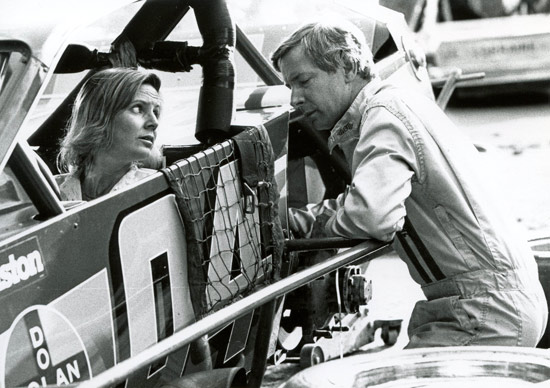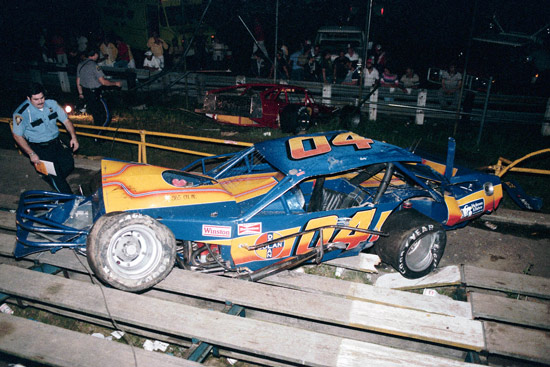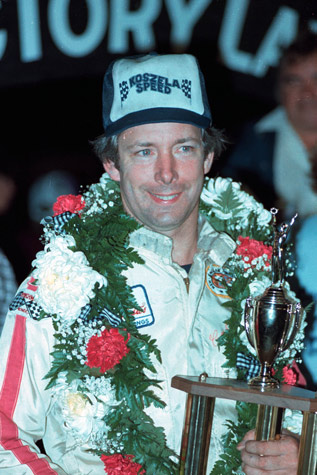|
6/5/13
CORKY COOKMAN
It was a time for beginnings.
In 1969 New York’s Lebanon
Valley Speedway had an affordable small block modified
class,
and, pits overflowing, there were typically two consolation races –
24 cars each – to handle the throng. We were just getting our start,
along with a lot of others.
Opening night, a coupe driven by
a “Black Bart” parked next to us. That was a fresh-faced Denny
Soltis who still dances there at the Valley 44 winters later.
On the other side was another beginner. He towed in with a black
Caddy four-door
sedan, a pretty square top Ford #04 out back. He
was a fit, handsome, well-dressed
young guy – understated with a
shy smile that used up only half his face. His image was not that of
the normal Saturday night throttle jockey. His name was Prentice
Cookman, but everyone called him “Corky.”
Like all of us,
Corky got banged around his share as he climbed up the learning
curve of those high banks. But he was a characteristically smooth
and deliberate driver, soon qualifying regularly for the mains. He
even took on Langhorne with that modest square top. And then, when
he copped a top ten in a 100-lap open competition at Lebanon, he
figured, “That’s as much as I can hope to do here,” and he started
building a big block Chevy coach for Middletown and Nazareth.
During the winter of ’71-72, I stayed with Corky
in Connecticut a few times while
promoting the first Spring
Sizzler race at Stafford Springs Speedway.
If Corky seemed a
tad unusual at the races, his situation at home was definitely out
of the ordinary. He lived in an apartment at Green Farms Academy, a
tony private finishing school, located on the magnificently groomed
grounds of a former Vanderbilt estate. Corky was the facilities guy,
handling all things building and grounds, equipment, and vehicles.
It seemed clinically perfect for him. He could go about his work in
his quiet, gentlemanly way and run all systems with his consistent
precision.
But there was something else. He was
well-respected and so he was allowed a big garage right there on the
premises to pursue his passion. With Corky Cookman, other than a
side order of hockey and the Rangers, racing was life.
He was
such a good guy. Out of friendship, he brought that unlikely big ol’
Middletown dirt coach up to our Spring Sizzler race on Stafford’s
asphalt. It didn’t work too well – there or later in the season on
the dirt. Corky, beginning to be quite the fabricator and
experimental designer, had come up with a rear suspension he was
sure would be the hot setup. When it wasn’t, he decided to go
pavement racing, at the old Danbury Fair
Racearena.
Arguably the polish of Corky’s driving style was more suited for
pavement than dirt.
Though he never won a feature at Danbury, he
was in the hunt: top ten in points three
out of four years.
Corky’s record was impressive in that he was doing everything
himself, with the part-time companionship and sponsorship of Bob
Ermark and Corky’s long time girlfriend, comely Carla McLean. Years
later Jim Torok bought and restored one of the Cookman Danbury cars.
He was surprised to discover that underneath, although an obsessive
Corky had fitted all the joints perfectly, he did not weld the
undersides. That, says Torok, was to save weight.
In the
end, though, Danbury suited Corky no better than the dirt. The
extremely popular but tightly contained quarter-mile was famous for
its crashes, often big, multi-car stackups. No one at Danbury was
spared the carnage, and Corky tired of carrying his meticulously
prepared creations home in a basket. He thought he would be better
off stepping up to a NASCAR modified.
It was high noon back
then at the turn of the eighties. NASCAR tracks in New England and
New York were lit with stars like Richie Evans, Reggie Ruggiero,
Jeff Fuller, Steve Park, Mike McLaughlin. Corky redoubled his focus.
If you called him on Thanksgiving Day, he would be working on the
#04. Or on building beautifully conceived hauling equipment or
tooling up his Green Farms shop.
When he appeared on NASCAR’s
stage, often accompanied solely by Carla, the troops
noticed
immediately the quality of his equipment and reliability of his
performance behind the wheel. However, there was a bit of small talk
in the background. Just who is this guy who looks more like a
teacher than a wildman racer, who interacts with people so
haltingly, and who is surely no steady customer at the beer stand
after the races? Dick Berggren remembers meeting Corky: “He seemed
so gentle somehow. Out of place. How can a guy like this relate to
the violence of modified racing?”
 |
Bob Ermark said
that in fact Corky and Carla made an unbelievably
good team.
(Howie Hodge photo) |
|
Before long rumors spread that Corky really was something
different – that he came from huge money related to the Otis
elevator fortune. Bob Ermark, who likely knew Corky as well as
anyone, says that, if wealth was in the picture, Corky never let it
show. Corky, he says, traded on hard work rather than any treasure
chest.
And over time, some guys – especially from smaller
teams – began to befriend Corky.
Among them was Brian Ross whose
very competent crew chief/son Chris worked with
Corky whenever
Brian was not running.
Another was modified car owner Ralph
Solhem, who worked off and on with Corky for
several years. “It
helped us both,” says Ralph today. “I had the knowledge and the
people to help him; he had all that great equipment in his shop to
help me – and he sure kept my passion going.”
It all worked
out. Corky was soon a top runner with NASCAR and took a prestigious
win at the Manchester Oil Heat 100 at Stafford in 1982.
But
racing can have its dark laps, and there was something curiously
star-crossed about the cautious Corky. A year after the Manchester
Oil Heat victory – in that same race at Stafford, Corky caught a
wheel on Mike Hornat’s car and was launched over the fourth- turn
wall. The catch fence collapsed, and the blue and yellow ’04 landed
in the stands, knocking out all the lights. It could only be
described as a battleground. Thirty-two fans were injured, though,
mercifully, no one died. Corky was understandably shaken physically
and emotionally, but his drive was undeterred. He was repairing the
car the next morning.
 |
| Stafford Speedway 1983. (Howie
Hodge photo) |
|
In 1985 the NASCAR Modified Tour was
conceived, replacing weekly shows with Series specials all over the
East Coast. Corky was right there on the roster, and it was, of
course, the year of the Richie Evans’ fatality at Martinsville. That
incident was horribly reenacted – once again at Martinsville – in
the spring of 1987 when Charlie Jarzombek died on that same
unforgiving wall. A sense of imminent danger hung over the modified
community.
On July 21 that year, Corky headed up to Thompson
for a Sunday-night Tour memorial
show that honored Jarzombek.
Ralph Solhem, just back from Wall Stadium the night
before,
joined in to help out. “It was strange traveling anywhere with
Corky. He did
enjoy his privacy, so there was lots of dead air
time. But that particular night, he talked about how hard it was to
keep going. We discussed whether he should just build a Busch South
car and run only six or so shows a year. He could have done that. He
wasn’t a hired-gun gasser type, but he was a tremendous racer.”
In the early stages of the feature, Corky, was running well,
just ahead of Bugsy Stevens and Brian Ross, motoring down the
backstretch. Both say they saw the right front dip down in a shower
of sparks before the car blasted the wall, spun around, and hit it
again with the rear.
As the safety crews pulled Corky out the
back window, fans in a packed bleachers
assumed it was bad. They
were right. The quiet 43-year-old was dead.
“It was a basal
skull fracture. Blunt force trauma,” says Ralph. “After that, rules
began to be tightened up with tires and with less rigid chassis.
When I got back from the hospital, Jerry Cook and I went and looked
over the car. It wasn’t good. We took the air cleaner off and could
see that the carb was still locked wide open. Just like in Charlie’s
car. And the carb rules were changed, too.”
Unfortunately,
that time of dying in the modifieds and all the sadness would extend
a few seasons longer. Tommy Druar and Don Pratt both perished in
1989, while Tony
Jankowiak was killed at the Spring Sizzler at
Stafford the next April.
“That period was so hard on us all,”
Brian Ross reflects. “You’ve got to realize that we were combatants,
but we spent each weekend with each other. We got close. People came
to admire Corky, even though he was a loner.”
There’s a
fundamental and sad irony in Corky’s end. Here was Corky Cookman,
quiet
and private, who chose the flamboyant and colorful arena
of the modfieds to express
himself, and it would be the arena
itself that took him away.
It just may have been hardest on
Ralph. “It’s funny I can’t say that I ever felt I REALLY
knew
him, but we sure were good friends. He’d call me all the time. We’d
talk about
setups. He would want to know everything that was
going on in racing, but he would
never ask anyone else himself.
It must have been a long, quiet struggle for him. If I was sleeping
late after a long race night or having a nap, that’s right when he
would call. I’m not kidding, even today when the phone rings at the
odd time, my first thought is ‘it’s Corky.’”
 |
| (Howie Hodge photo) |
|
|